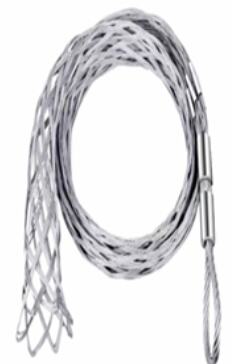1. Diverse Materials
Typically woven from high-strength synthetic fibers or metal wires.
Synthetic fiber socks are lightweight and flexible, suitable for delicate cables or situations requiring easy maneuverability.
Metal wire socks offer high strength and abrasion resistance, ideal for heavy-duty applications or rough terrain.
This material diversity ensures adaptability to different cable types and pulling requirements.
2. Flexible Structure
Designed with a mesh structure, the sock can self-adjust to the thickness and shape of the cable, providing a tight and secure wrap. This flexibility allows it to accommodate various cable specifications and ensures uniform force distribution during pulling, reducing the risk of cable damage.
3. Excellent Anti-Slip Performance
The inner surface of the sock usually features a rough texture or anti-slip design, Which effectively prevents cable slippage during traction. This ensures stable and reliable pulling, even under high tension or sudden force changes, making it a critical safety feature in cable laying projects.
1. Easy Operation
Installation and removal are quick and straightforward, requiring no complex tools or specialized skills. This simplicity significantly improves construction efficiency, allowing teams to complete cable laying tasks more rapidly, especially in time-sensitive projects.
2. Cable Protection
During cable laying, the sock evenly distributes traction force, preventing excessive localized stress on the cable that could damage its insulation layer or sheath. By minimizing mechanical strain, it preserves the structural integrity and electrical performance of the cable, ensuring long-term reliability of the power system.
3. Reusability
High-quality cable pulling socks exhibit excellent durability, maintaining optimal performance even after multiple uses. Their reusable design reduces construction costs by eliminating the need for frequent replacements, making them a cost-effective choice for repeated or large-scale cable installation projects.
1. Cable Traction
Primarily used for pulling operations during cable laying. The sock is fitted over the end of the cable, and traction is applied through the sock to guide the cable smoothly through pipes, cable trays, or other obstacles. This method ensures controlled and efficient cable installation, especially in complex routing scenarios.
2. Cable Fixation
During cable installation, maintenance, or positioning, the sock can secure the cable in a specific location to prevent swaying or displacement. This is particularly useful in overhead installations, vertical runs, or areas prone to vibration, ensuring the cable remains stable and reducing the risk of mechanical damage or misalignment.

| Model | Applicablecable diameter(mm) | Finishedproduct length(m) | Weight(kg) | Single wirediameter(mm) | Weavingprocess |
| 10-20 | 10-20 | 0.70 | 0.16 | 1.2 | 3x4 |
| 20-25 | 20-25 | 0.84 | 0.25 | 1.2 | 3x5 |
| 25-50 | 25-35 | 1.20 | 0.50 | 1.6 | 3x5 |
| 35-50 | 35-50 | 1.40 | 0.70 | 1.6 | 3x6 |
| 70-95 | 50-60 | 1.50 | 0.70 | 1.8 | 3x6 |
| 120-150 | 60-80 | 2.00 | 1.30 | 2.5 | 2x6 |
| 185-240 | 80-100 | 2.40 | 1.80 | 2.5 | 2x7 |
| 300-400 | 100-120 | 2.85 | 2.70 | 2.5 | 2x8 |
| 500-630 | 140-160 | 2.90 | 3.80 | 2.5 | 3x8 |
| All measurements provided are manually obtained and may contain slight tolerances. Final dimensions shall be subject to the physical product | |||||
Our professional sales team are waiting for your consultation.